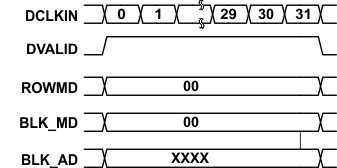DLPS024G August 2012 – February 2020 DLPC410
PRODUCTION DATA.
- 1 Features
- 2 Applications
- 3 Description
- 4 Revision History
- 5 Description (continued)
- 6 Pin Configuration and Functions
- 7 Specifications
-
8 Detailed Description
- 8.1 Overview
- 8.2 Functional Block Diagrams
- 8.3
Feature Description
- 8.3.1
DLPC410 Binary Pattern Data Path
- 8.3.1.1 DIN_A, DIN_B, DIN_C, DIN_D Input Data Buses
- 8.3.1.2 DCLKIN Input Clocks
- 8.3.1.3 DVALID Input Signals
- 8.3.1.4 DOUT_A, DOUT_B, DOUT_C, DOUT_D Output Data Buses
- 8.3.1.5 DCLKOUT Output Clocks
- 8.3.1.6 SCTRL Output Signals
- 8.3.1.7 Supported DMD Bus Sizes
- 8.3.1.8 Row Cycle definition
- 8.3.1.9 DLP9500 and DLP9500UV Input Data Formatting
- 8.3.1.10 DLP7000 and DLP7000UV Input Data Bus
- 8.3.1.11 DLP650LNIR Input Data Bus
- 8.3.2 Data Bus Operations
- 8.3.3 DMD Block Operations
- 8.3.4 Other Data Control Inputs
- 8.3.5 Miscellaneous Control Inputs
- 8.3.6 Miscellaneous Status Outputs
- 8.3.1
DLPC410 Binary Pattern Data Path
- 8.4 Device Functional Modes
- 8.5 Programming
- 9 Application and Implementation
- 10Power Supply Recommendations
- 11Layout
- 12Device and Documentation Support
- 13Mechanical, Packaging, and Orderable Information
Package Options
Mechanical Data (Package|Pins)
- DLP|676
Thermal pad, mechanical data (Package|Pins)
Orderable Information
8.3.2.3 No-Op Row Cycle Description
A Row No-Op is a row cycle in which setting ROW_MD = "00" commands the DLPC410 that within the current row cycle, no Row Write operation is to be performed. A Block No-Op is a row cycle in which BLK_MD = "00" commands the DLPC410 that within the current row cycle no Block Operation is to be performed. Row No-Ops can be inserted when only block operations are desired, Block No-ops can be inserted when only Row Write operations are desired, or both Row No-Ops and Block No-Ops can be performed at the same time when neither type of operation is desired (as shown in Figure 10). No-Ops are frequently inserted in the stream of data and commands when delays are desired to complete on-going operations to avoid violating delay requirements.
 Figure 10. No-Op Row Cycle (DLP7000 example)
Figure 10. No-Op Row Cycle (DLP7000 example)